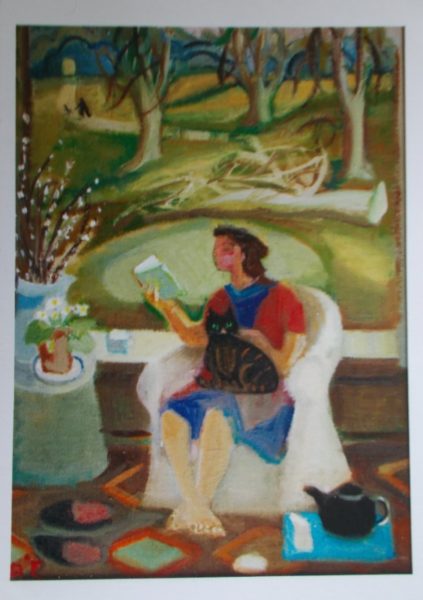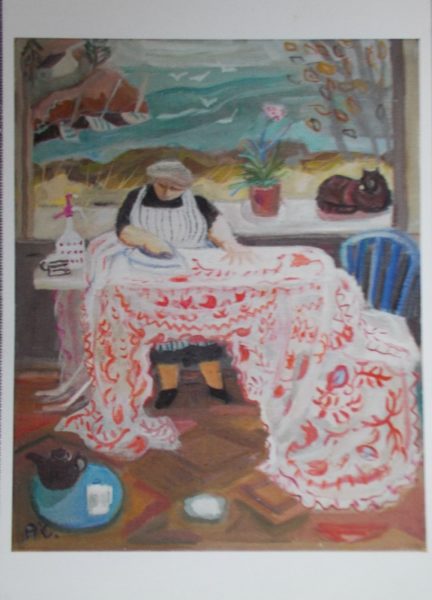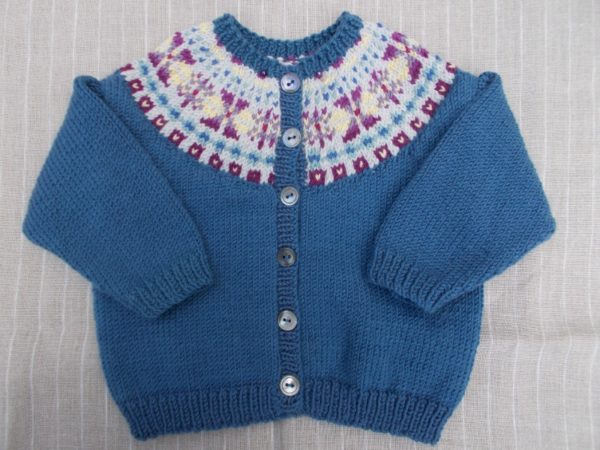
Cardigan with Fair Isle Yoke 6-9 months (Pattern: Debbie Bliss Baby Cashmerino, pub 2002 by Designer Yarns)
I’m on the verge of running out of tiny babies to knit for which is a shame because I love these sorts of garments that progress rapidly and show results in no time at all. Small cardigans like this (for a baby 6-9 months) take just over 2 balls of yarn, not counting the strands of colour for the Fair Isle. I have exactly the right amount of the colour called silver which is tempting me to just get on and knit one of the smallest sizes anyway on the off chance a baby will appear and you know, one usually does! But then again I have committed myself to knitting for bigger children, so perhaps I’ll just have to resist. Oh, the trials of marrying the urge to do one thing in the face of good reasons to do something else !
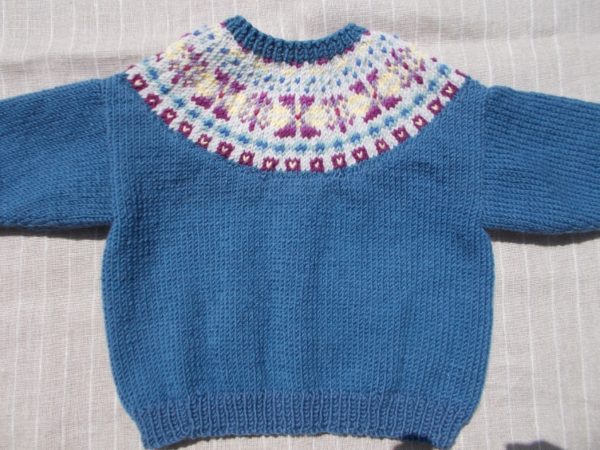
Back view: Cardigan with Fair Isle Yoke 6-9 months (Pattern: Debbie Bliss Baby Cashmerino, pub 2002 by Designer Yarns)
I happened to notice in yesterday’s Times that British ballet dancer Beryl Grey (Dame) was 94 on Friday and I had a sudden flash of memory as I recalled seeing her once in a shop about 30 ago. All that collecting of ballet cards free with Judy as a child (or was it Bunty?) obviously paid off as I recognised her immediately. I stood stock still and probably slack jawed , marvelling at such the diminutive, immaculately dressed and chignon-coiffured individual before me. I remember nothing of the where or when of the occasion but the image of HER is as vivd today as it was initially. Even 30 years ago, it was unusual to see someone turned out with such elegant perfection – it was as if I’d walked into Audrey Hepburn, filming ‘Charade’, divine in Givenchy.
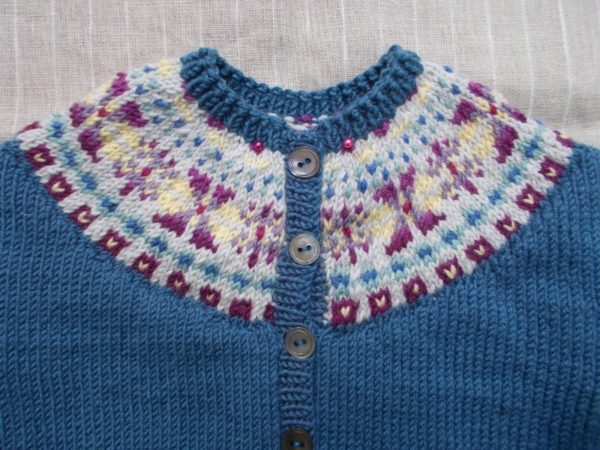
Detail of front: Cardigan with Fair Isle Yoke (6-9 months Pattern: Debbie Bliss Baby Cashmerino, pub 2002 by Designer Yarns)
I think it was the costumes that drew me into liking ballet. I was enchanted by a world that contained acres of frothy tulle, tutus that defied gravity and stuck out horizontally from the body and the baroque embroidery which drew attention to tiny waists, delicate shoulders and impossibly long bird-like necks. Then opera trumped ballet. While the children were little, theatre visits dropped down the list of priorities, but then we had the good fortune to know someone through the children’s school who had a job at the Royal Opera House. The ROH was going through a difficult patch – something to do with booking problems caused by the complexities of debenture holders having first dibs of the tickets – so sometimes quite large numbers of tickets could suddenly become available as seats needed to be filled. Saturday matinees were the usual problem times which were perfect for those of us with children who didn’t like to disrupt tea time and bed time. On one occasion we hauled my 89 yr old father (living with us) to see Giselle and though he had no great desire to watch ballet dancing, he embraced the experience enthusiastically, sat face shining with pleasure, occasionally shaking his head in disbelief and patting the children’s hands with delight. On the way home, he couldn’t get over where he’d been and would say to anyone who let him “I never expected to be doing that at 89!”

Sampler swatch
I can’t remember how many times we benefited from this largesse but I do remember one particular Saturday matinee when the bookings had been so lamentable that we had seats in the stalls not many rows from the stage. This must have been disastrous for the ROH as the afternoon’s programme was a world premiere of 3 new ballets. Unfortunately daughter No 3, who must have been under 5 at the time, found it all too much and ended up asleep, somehow spread across more than one of the plushest of plush red velvet seats! Fortunately she slept silently, but how dreadful it must have looked from the stage.
We never made any attempt to get my son to join us on these outings to Covent Garden for I had learned early on in his life that he wasn’t at all keen on the theatre. Aged 3, he and I accompanied daughter No 2’s school class to a dramatisation of the Meg and Mog books at the Unicorn Theatre which used to be just off Charing Cross Road and which specialised in children’s entertainment. He wasn’t noisy but he made it quite clear early on in the performance that he wasn’t happy and was getting no joy from what was going on on the stage. I know when not to back a dead horse, so he and slipped out. It was a winter afternoon just before Christmas. The streets were sparkly, animated by an imminent Christmassy feeling and proved to be a much better place to be in his mind. He was much happier walking around Covent Garden’s theatres for a couple of hours than actually sitting in one. I was exhausted by the time we met up with the rest of the school party!
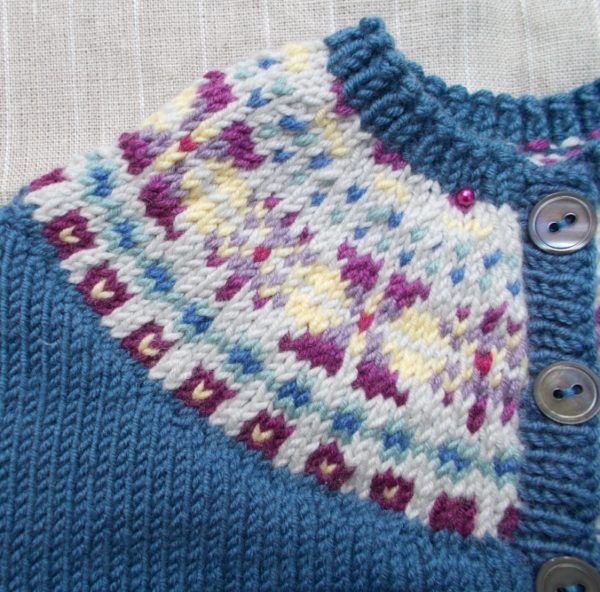
Yoke detail: Cardigan with Fair Isle Yoke (Pattern: Debbie Bliss Baby Cashmerino, pub 2002 by Designer Yarns)
While knitting this cardigan (and the jumper before, seen here) I decided I didn’t like the colour – I think it’s called Denim. Fortunately as I photographed it today I saw it in a different light and came round to liking it. Perhaps it’s the sun. Perhaps I’m more fickle than I realised. This is the tenth cardigan I’ve knitted with a Fair Isle yoke.
Fair Isle Design No 143 from Mary Jane Mucklestone’s 200 Fair Isle Designs (Search Press, 2011)

